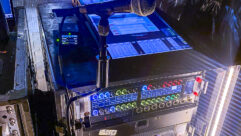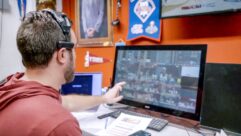Delivering the word
Sep 1, 1999 12:00 PM,
Stephen Whitesell
With a legacy dating back 144 years, St. Joseph the Work-man Cathedral,Lacrosse, WI, was founded by French, German, Polish and Irish immigrants.Their lineage of almost 3,000 parishioners still attend the Cathedral atthe newest building, which was constructed in 1962. The cathedral is acontemporary interpretation of the gothic architecture of the original. Tothe benefit of current parishioners and their posterity, native quarrystone was used in its construction. Adding to its uniqueness, the cathedralhas a 4,300-pipe church organ valued at more than $1 million.
As with all modern pulpits, St. Joseph’s is dependent upon technology toincrease the intelligibility of the spoken word. Several sound systems havebeen used in the past 37 years, none reaching the desired clarity. Inlooking for a new sound system, Father Cook contacted Richard Grundgeigerat Celestial Sound Systems, Madison, WI.
“We entered into plans for a new sound system with trepidation, but we werefortunate enough to meet Richard,” Cook said. “It unfolded into anexcellent and cost-effective project.”
Grundgeiger said, “Interestingly, the real reason Father Cook was callingme was because his two older lavalier wireless mic systems didn’t seem tobe working well and the local sound contractor had promised that if hebought two new wireless mic systems at $1,500 each plus installation, allhis sound system problems would be over. He had checked with one of hischurch members who was a TV station engineer, and he also confirmed thatgetting the two new wireless mic systems was the right thingto do. I saidthat my intuitive reaction and more than 30 years experience in improvingchurch sound systems made me concerned and skeptical that he would feel thechurch’s money was well spent after two new $1,500 wireless systems wereinstalled.”
Grundgeiger offered to come down to the cathedral to survey the existingequipment and make a recommendation. On the following Saturday morning, hearrived just as noon Mass was ending. Because Father Cook was called awayat the last minute, and the substitute priest did not know much about thesound system, he had to sort out the system himself. After finding theequipment rack, making a few notes and spending about and hour and a halfsketching out rough drawings of the cathedral showing distances and takingsome photos, he set his sights on the errant mics.
“After bending the battery clips in one of the beltpack transmitters andreplacing the intermittent shorting lavalier mics of both systems withloaner mics I carry with me,” Grundgeiger said, “I had both of the existingsystems working well. I left Father Cook a note letting him know that I wasable to temporarily fix his two existing wireless mic systems so he couldget better use out of them and that I would be writing him a letteroutlining suggestions on improving his sound system in a few days”.
Having done hundreds of installations in houses of worship, Grundgeigerfollows a method when designing a sound system. He first visits the church,meeting with the pastor and ministers. Then, he spends time in the churchlistening, taking reverberation and other measurements, taking notes andphotos, and making drawings. Lastly, he returns to his office to design theinstallation. He combines cost-effective solutions with high-performance,problem-solving equipment.
Grundgeiger enjoys working with small country churches, and he said, “Wewant to become part of the church’s team, focusing on its needs. We areinterested in getting the best improvement possible for the availabledollars”.
Initially, Grundgeiger quoted the price to install the two same wirelessunits Father Cook had asked about, but he continued in his assessment ofthe system saying that he thought it would be a good idea to replace thetwo existing six-channel manual mic mixers and the two existing 1/3-octaveEQs with four new ones. A new distribution preamp (Rane SM-26B) and ACsurge protected on/off panel was indicated. Also, some limiting andfeedback control would help improve the sound quality. The existing Crownamps were fine and could continue to be used. He also indicated that addinga pair of Shure SC-14/85 lavalier wireless mic systems with remote antennasto the current complement of systems would enhance the hearing assistancesystem by adding in all the orators on the pulpit and that he wouldreinstall the entire package inside the existing wall hanging cabinet,thereby eliminating the unsightly draped wires.
Grundgeiger said, “All of this could be done for about $9,500, and I askedhim for a time when I could meet with him and some of his interested churchmembers to explain these recommendations in more detail and also tocomplete my survey”.
There were many unique features and problems to overcome in the install.About nine years earlier, a completely new sound system had been installedin the cathedral that used a number of horns and bass cabinets suspended ina hanging custom 169 infinity 169 infinity 69 (4.9 m infinity 4.9 minfinity 1.8 m) central cluster, to serve the main nave seating facing thealtar. The sanctuary had 4 inch (102 mm) loudspeakers hidden in the ornate,decorative wooden chair canopies along the side of the sanctuary. Thesmaller pew seating area facing the rear of the sanctuary had six 8 inch(203 mm) loudspeakers built into the existing hanging light fixtures. Thechoir loft had a single delayed monitor loudspeaker. In addition, the choirloft had an 89 infinity 59 infinity 59 (2.4 m infinity 1.5 m infinity 1.5m) choir origination cluster with two horns and one bass cabinet and aseparate sound system in a floor standing cabinet located in the choirloft. The original sound contractor had! spent many long hours fine tuning and balancing the sound system, and it was a substantial improvementover previous sound systems. There were, however, some dead spots, and manyof the older members complained that it was difficult for them tounderstand everything during a worship service.
The church board had enlisted the aid of a prominent architectural firm afew years after the sound system was installed to see if there could be anyimprovements to the sound system. The architectural firm brought in severaldifferent sound contracting firms, but none was able to suggest anythingthat would improve the speech intelligibility without adding acousticaltreatment. Father Cook explained that because of the stone and marbleconstruction and a million-dollar organ with a prominent organist on staffwho did not want to change the reverberation times within the church,acoustical treatment was not an option. The quarried stone cathedral,although considered by the organist to be acoustically excellent for music,was a disaster for intelligibility of the spoken word. The echo within thenave, for example, was fatiguing on Father Cook, and reverberation timesthroughout the church were as high as six seconds.
“About four weeks went by,” Grund-geiger said, “and I was about to callFather Cook fearing that he may have purchased the two new wireless systemsfrom the local sound contractor, when suddenly the voice on the other endof the phone said, `Richard, this is Reverend Cook. I showed your letter toa few of my church members and they all think it is a good idea. Go aheadand put the $9,500 worth of improvements in.’ I responded by thanking himfor allowing me to go ahead with the first step in improving theperformance of his sound system. I let him know that it will make asubstantial and noticeable difference, but there is more that will have tobe done in order to reach complete speech intelligibility that will allowevery visitor and church member the ability to hear and understandeverything that is being said. A few weeks later, I was able to install thenew equipment.”
As it turns out, the existing central cluster was hard to equalize. Itsounded harsh and metallic, and there were dead spots and uneven coverage.
“I was able to take reverberation readings with my Communications CompanyBONG-2 Burst Octave Noise Generator and RT-60B Reverberation Timer, whichwill produce readings for 125 cps to 8,000 cps. As I expected, thereverberation times were as high as six seconds,” said Grundgeiger. “Itried everything I could to wring every ounce of improvement out of the newelectronics and the existing loudspeaker systems, even attending Sundaychurch Mass a couple of extra Sundays. Finally, Father Cook told me thatthe people who always complained about not being able to hear have noticedthe improvement, but most of them said that it was a long way from beingable to hear easily. The only solution left was to bring the loudspeakerscloser to the listeners.”
To solve the issue of uneven coverage that the old system provided,Grundgeiger installed three pairs of hanging SoundTube RS100 loudspeakers20 feet (6.1 m) above the floor. According to Grundgeiger, theseloudspeakers would provide the basic overall envelope of sound for thisarea, which is approximately 105 feet (32 m) long by 65 feet (19.8 m) wide.A total of eight small Tannoy C-60 Arena loudspeakers, four on each side,were used for fill along the side walls where the sound tended to fall offslightly and was obstructed by massive 5 feet (1.5 m) diameter columns. Thesanctuary area is approximately 709 infinity 659 (21 m infinity 19.8 m) andwould be served with 14 additional Tannoy C-15 Arena loudspeakers. Some ofthese loudspeakers were to be concealed in the ornate canopies of the sideseating, and some would be mounted 1 foot (305 mm) above the marblesanctuary floor on the rear of the pulpit, lectern and railing. An addedbenefit of placing the small Tannoy Arena mo!nitor loudpeakers partially within the pulpit and lectern is the monitoring assistance they would provideto the persons speaking at those locations, thereby allowing them to speakmore naturally. This new system helped eliminate the intelligibilityproblems by providing a wider, more diffuse dispersion of sound pressure inthe room. The excessive reverberation times were further diminished throughcareful adjustment of a time delay in a distributed system between all sixSoundTube loudspeakers.
One parishioner said, “The sound was just wonderful. I understoodeverything easily and the new loudspeakers look beautiful. I didn’t noticethem at first. It took me a minute to realize where they were.”
The Priest noticed right away that it took less effort to capture theattention of everyone in the nave because the reduced reverberation timewas far less fatiguing on an orator.
To match the quarried walls aesthetically, Grundgeiger asked SoundTubeEntertainment for a custom enclosure color. SoundTube received a sample ofthe quarried stone and was able to custom match the loudspeaker enclosuresto blend with the surrounding colors.
The seating facing the rear of the sanctuary, an area of about 509 infinity509 (15 m infinity 15 m) had six existing pendant lamp fixtures with 8 inch(203 mm) loudspeaker enclosures. The old, worn-out loudspeakers in theseenclosures were replaced by six Posh 8 inch (203 mm) SP9 raw frame speakerswith T-15 15 W, 70 V transformers. For increased acoustic quality, twoAM8-TC Lectrosonics eight-channel automatic mic mixers were installed,along with one Sabine FBX-2020 dual automatic feedback reducer and oneSymetrix 421M Audio Leveler. Two DSP-1100 Behringer Dual automatic feedbackreducers were also added to the system, along with two GRQ-3101 Sabineprocessors. Room equalization was accomplished thanks to a pair of MQX2310Ashly Dual 31 Band EQs and one E-31 Samson 31-band 1/3-octave EQ.
After the new loudspeakers were installed, the different amp channels werecarefully equalized, reusing the existing Crown amplification. The1/3-octave EQs were tuned using an IE-30A Ivie audio analyzer with IE-20BIvie noise generator.
“It didn’t take long before everyone was stopping Father Cook after Mass totell him just how much better they thought the sound system was and howthey could now finally hear everything,” said Grundgeiger.
In looking back at the project, Mr. Grundgeiger believes that the key tosuccess was Father Cook’s deep commitment to improving clarity and qualityof the spoken word.
Grundgeiger said, “The exceptional quality and performance of the newSoundTube RS100 hanging loudspeaker system and the fact that SoundTube wasable to make a custom color to match the stone sample of the interiorchurch walls really were the important pieces of the puzzle that madeeverything come together. As usual, the Tannoy Arena ICT technology fillloudspeakers and the Posh SP9 drivers did an excellent job where they wereneeded.”
Father Cook said, “The word of the gospel is better, more gratifying,easier to understand and ultimately, the pews are fuller.”
Since the install, attendance has grown consistently, and one parishionersaid, “Now, finally, the beauty and impact of the spoken word far outshinesthe physical beauty of the worship space.”










